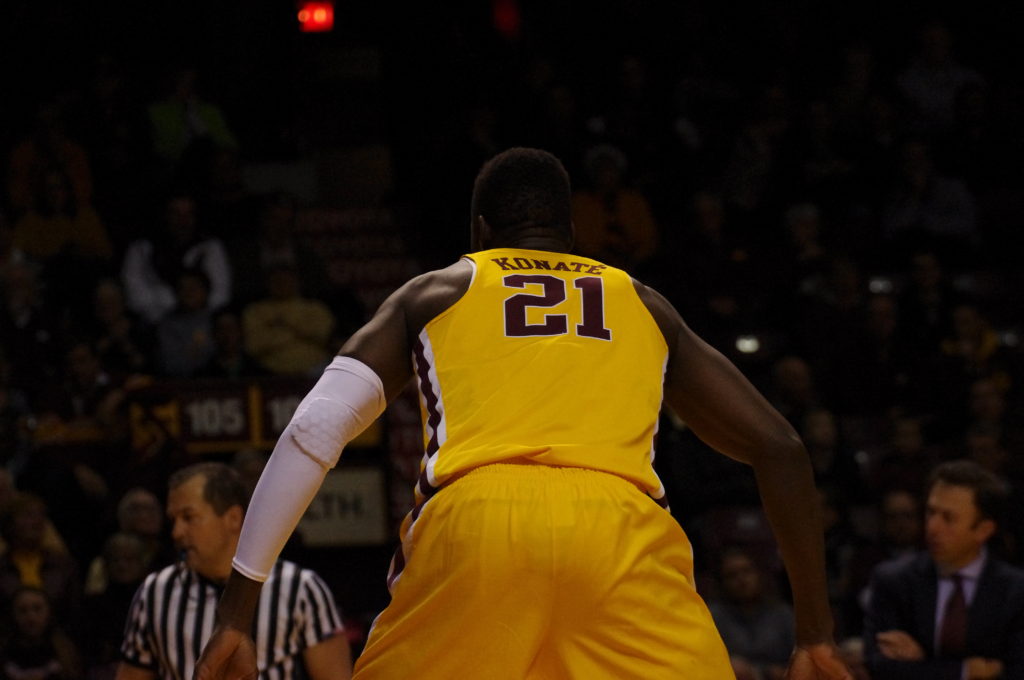Written By Sam Ekstrom (ColdOmaha.com)
Photo Credit: Brian Curski
Less than two weeks ago, the Minnesota Golden Gophers were the talk of the town. Coming off a convincing win over Ohio State, Minnesota was tied atop the Big Ten and had earned its first Top-25 ranking in four years.
How three games can change a narrative.
Minnesota went on the road and dropped two straight games to Michigan State and Penn State, then returned home and lost an emotional overtime thriller to No. 17 Wisconsin, sending the Gophers below .500 in conference play and suddenly in danger of losing their grip on what appeared to be a likely NCAA Tournament bid.
The Gophers are 3-4 in the rugged Big Ten. They could easily be 6-1. They could also be 1-6. It’s just that kind of year in one of the country’s premier conferences. There are no elite teams, and maybe not a single title contender at the moment. There are, however, 14 teams who all appear capable of winning any given night, especially on their home floor, leaving no gimmes on the schedule and making end-of-game execution the deciding factor in a majority of conference contests.
Minnesota’s first three conference games all came down to the final minutes. The Gophers missed a pair of game-winning shots in the Big Ten opener against Michigan State at home. Then they rebounded with a gritty overtime win against ranked Purdue and a late comeback over cold-shooting Northwestern.
All three games could have gone either way. The Gophers were fortunate to win a pair of them.
After a fairly one-sided win over Ohio State and a decisive loss in East Lansing, the Gophers have played two more gut-check games that came down to the final shot and lost both. Against Penn State, the Gophers blew an 11-point second half lead, scored just two points in the final 3:27 and failed to force overtime as Akeem Springs missed a putback at the buzzer. In Saturday’s barnburner in front of sold out Williams Arena, Minnesota went on a five-plus minute scoreless drought before Springs forced overtime with a late 3. But with better poise on the offensive end, the Gophers likely clinch the game in regulation.
Bottom line: In games that have come down to the wire, Minnesota is 2-3. The teams that will inevitably come out of the Big Ten and receive tourney berths will be the squads that execute down the stretch and finish the year better than .500 in close games.
This trend is already starting to develop across the conference. Ohio State (2-5 Big Ten) is 2-3 in games decided by five points or fewer. Maryland (5-1), tied for the Big Ten lead, is 4-1 in games decided by eight points or fewer.
Nebraska (3-4), once considered the doormat of the Big Ten, has had all seven of their conference games decided by eight points or fewer. Wisconsin (5-1), the conference co-leader, is 3-0 in games decided by seven or fewer, including, of course, Saturday’s dramatic win in Minneapolis.
A quick glance at the Gophers’ schedule presents no clear victories. Not even a trip to Rutgers will be a cakewalk in the current climate. Minnesota needs to clean up its late-game issues, and fast. “It’s hard when Bakary’s in because you don’t necessarily have the low-post threat,” said Pitino, alluding to starting center Reggie Lynch’s penchant for foul trouble. “I thought our flow was a little screwed up there.”

Konate has proven to be a much better defender in his junior season and, at times, a better option than the lanky Lynch against the conference’s elite big men. But Konate’s offensive game still lacks punch, as does his rebounding. Konate failed to grab an offensive board in the closing seconds against the Badgers that could have led to a go-ahead layup. Lynch has fouled out in five of seven Big Ten games and is becoming a liability in that regard.
The Gophers also need more from another junior, Nate Mason, who struggled shooting for the fifth game in a row on Saturday. He’s shooting 26 percent since his 31-point explosion against Purdue. “He’ll be fine,” said Pitino after the Wisconsin game. “I don’t worry about him too much. Obviously a couple of good looks, just needs to knock them down, but he’ll get it back.”
Mason was more critical of himself the day prior to the Wisconsin game, saying he needed to display better leadership. “I’ve been doing a horrible job of leading,” he said frankly. “That’s something I have to better at. It gets me out of my comfort zone where I have to be more vocal than I normally am.”

The silver lining for the Gophers is that playing a schedule packed with coin-flip games means that every game is there for the taking. While there are no simple games remaining, there are no unwinnable ones either. And a 9-9 Big Ten finish would likely be enough to reach the Big Dance.
Propelled by a reinvigorated home crowd, the Gophers’ likeliest path is simply to take care of business at home, where they play six of their 11 remaining games and have only been beaten in overtime.
“I wouldn’t trade this environment for anything in the world,” said Pitino. “We don’t need it versus Wisconsin, though. We need it every night. … That is a fun, fun environment, and our guys feed off it, and that’s what the Big Ten is all about. I’ve said it a lot. I get why people gave up on our team last year. I wouldn’t blame them. I wouldn’t spend my money to watch that group either, but this is a fun group to cheer for, and that’s what the Big Ten is all about. This place can be special; really, really special when it’s good.”
The Gophers have proven they have the talent to compete with any team in the conference. The next step is learning how to win consistently.








